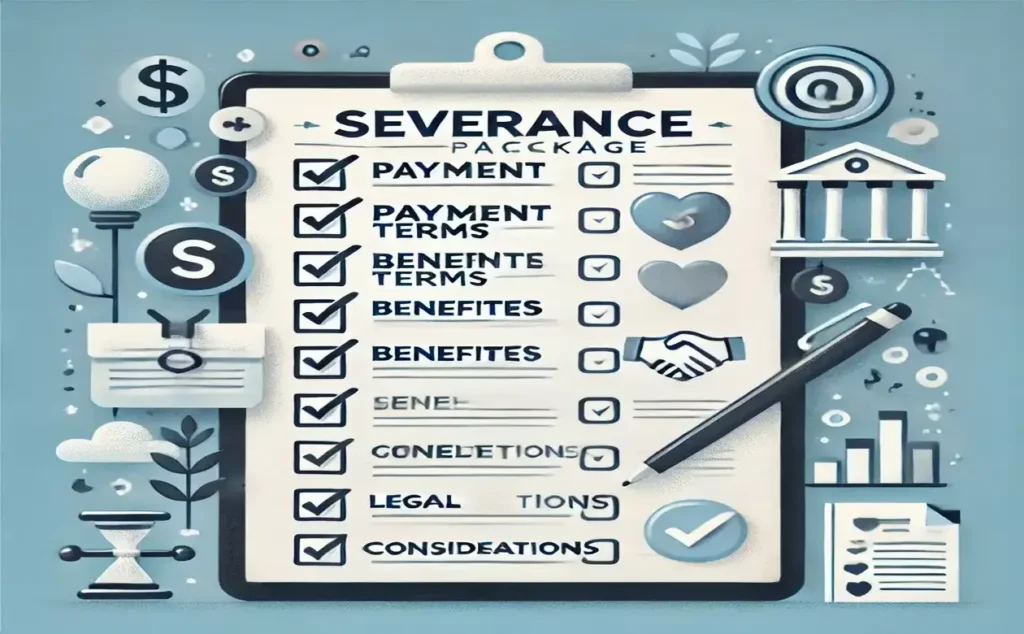7 Essential Facts About Severance Packages When Fired

Do you get a severance package if fired? A number of employees who are faced with involuntary displacement grapple with this issue as well. Understanding your rights and options can make a significant difference in your financial stability and future career prospects. Let’s dive into the world of severance packages and uncover what you need to know when facing termination.
What is Severance Package?
Severance package is a form of financial compensation offered by employers to employees who are leaving their jobs, often due to circumstances beyond their control. This package can provide a crucial financial cushion during the transition period between jobs, helping employees maintain their standard of living while seeking new employment opportunities.
Although severance packages are not legally required in most instances, they have become a standard practice across many industries. Exit compensation arrangements differ significantly, influenced by organizational guidelines, sector norms, and personalized discussions between employers and departing staff members. Understanding the ins and outs of severance packages is essential for any employee, as it can significantly impact your financial well-being in the event of job loss.
Key Takeaways
• Severance packages are not legally required in most cases, but are often offered by employers voluntarily
• Eligibility usually relies on factors such as the reason for termination, company policy, duration of employment, and job position
• Common components include severance pay, benefits continuation, outplacement services, and agreements on legal releases or non-compete clauses
• Severance pay is usually calculated based on length of service, often 1-2 weeks of pay per year worked
• Packages may include continued health insurance (often through COBRA), payment for unused vacation time, and information on retirement plan/stock option impacts
• Negotiation is often possible, especially for higher-level employees or those with specialized skills
• Accepting severance may require waiving rights to sue the company or file for unemployment benefits
• The Internal Revenue Service typically classifies exit compensation as earnings subject to taxation.
• Some states have laws requiring severance in cases of mass layoffs or plant closings (e.g. NJ, NY, CA WARN Acts)
• Employees usually have time to review agreements (21 days for those over 40 under ADEA)
• Packages aim to ease transition and protect companies from potential lawsuits
• Think about seeking advice from an employment lawyer before signing any severance agreement
• International practices vary significantly by country
• Future trends may include gig economy considerations and increased transparency in severance policies
Understanding Employment Termination
Before delving into the specifics of severance packages, it’s crucial to understand the different types of employment termination and how they can affect your eligibility for severance pay.
Types of Termination
Employment termination can occur in several ways, each with its own implications for severance:
- Layoffs: When companies reduce their workforce due to economic factors or restructuring, affected employees may be eligible for severance.
- Firing for cause: Termination due to poor performance, misconduct, or violation of company policies may result in ineligibility for severance.
- Voluntary resignation: Employees who choose to leave their jobs typically don’t receive severance, although exceptions may exist in certain circumstances.
- Mutual agreement: Sometimes, employers and employees may agree to part ways, often involving negotiated severance terms.
At-Will Employment
The majority of work arrangements in the U.S. fall under the ‘at-will’ doctrine, allowing both parties to terminate the professional association freely, with certain limitations. This principle grants employers and employees alike the flexibility to dissolve their working relationship at their discretion, barring specific legal constraints.
This concept plays a significant role in determining severance eligibility, as employers are generally not obligated to provide severance pay unless specified in an employment contract or company policy.
Severance Packages Explained
Severance packages are designed to provide financial support to employees during their transition period after leaving a job. These packages can vary significantly in their composition and value, depending on various factors.
Components of a Typical Severance Package
A comprehensive severance package may include:
- Severance pay: Usually calculated based on length of service and salary level
- Continuation of health benefits: Often through COBRA coverage
- Professional transition support: Guidance on career paths and aid in seeking new employment
- Stock options or other equity compensation
- Prorated bonuses or commissions
- Accrued vacation or paid time off
- Letters of recommendation
- Non-compete agreement waivers
Legal Requirements for Severance Pay
Contrary to popular belief, there is no federal law in the United States that requires employers to provide severance pay. The Fair Labor Standards Act (FLSA), which governs many aspects of employment, does not mandate severance packages. However, there are some exceptions:
- Employment contracts: If your contract specifies severance terms, the employer is legally bound to honor them.
- Company policies: If an employer has established a severance policy, they may be obligated to follow it consistently.
- Collective bargaining agreements: Union contracts may include provisions for severance pay.
- State laws: Some states have laws requiring severance pay under specific circumstances, such as mass layoffs or plant closings.
Do You Get a Severance Package if Fired?
The short answer is: it depends. Whether you are offered a severance package upon termination mainly depends on the specifics of your dismissal and your employer’s policies.
Factors Influencing Severance Eligibility
Several factors can influence whether you’ll receive a severance package if fired:
- Reason for termination: Employees fired for cause (e.g., misconduct or poor performance) are less likely to receive severance than those let go due to downsizing or restructuring.
- Company policy: Some organizations have established severance policies that apply to all eligible employees, regardless of the reason for termination.
- Length of service: Long-term employees may be more likely to receive severance, even if fired for performance issues.
- Industry standards: Certain industries have more generous severance practices than others.
- Negotiation: In some cases, employees may be able to negotiate a severance package even if not initially offered.
Company Policies and Severance
Many companies have formal severance policies outlined in their employee handbooks or HR documentation. These policies typically specify:
- Eligibility criteria for severance
- Calculation methods for severance pay
- Additional benefits included in the package
- Conditions for accessing termination benefits (e.g., endorsing a waiver document)
It’s essential to familiarize yourself with your company’s policies to understand your rights and potential benefits in case of termination.
Circumstances Where Severance May Be Offered
While severance isn’t guaranteed when fired, certain circumstances make it more likely that an employer will offer a package.
Layoffs and Downsizing
During economic downturns or company restructuring, employers often provide severance packages to employees affected by layoffs. This practice helps maintain goodwill, supports affected workers, and can mitigate potential legal risks associated with mass terminations.
Mergers and Acquisitions
When companies merge or are acquired, redundancies in the workforce often occur. In these situations, severance packages may be offered to employees whose positions are eliminated or who choose not to continue with the new organization.
Voluntary Separation Programs
Some companies offer voluntary separation or early retirement programs to reduce their workforce. These programs typically include attractive severance packages to incentivize employees to voluntarily leave their positions.
Negotiating a Severance Package
Even if your employer doesn’t initially offer a severance package, or if you believe the offered package is inadequate, you may have room for negotiation.
Key Elements to Consider
When negotiating a severance package, consider the following elements:
- Severance pay amount and duration
- Continuation of health benefits
- Outplacement services or career transition support
- Handling of share-based incentives and alternative ownership rewards
- Non-compete or non-disclosure agreement terms
- References and future job search support
Strategies for Successful Negotiation
To enhance the likelihood of a favorable outcome in your discussions:
- Research industry standards and your company’s past practices
- Build a compelling case that emphasizes your contributions and worth to the company
- Consider timing – negotiate before signing any termination agreements
- Be professional and respectful throughout the process
- Consider seeking legal advice, especially for complex situations or high-value packages
Legal Protections and Employee Rights
While severance pay isn’t legally required in most cases, there are laws that protect employees’ rights during termination processes.
WARN Act and Mass Layoffs
The Worker Adjustment and Retraining Notification (WARN) Act mandates that employers with 100 or more employees must give a minimum of 60 days’ notice prior to mass layoffs or facility closures. Failure to comply can result in penalties, including paying employees for the notification period.
Anti-Discrimination Laws
Federal and state anti-discrimination laws prohibit employers from making termination decisions based on protected characteristics such as age, race, gender, religion, or disability. If you believe you’ve been discriminated against, you may have legal recourse, which could impact your severance negotiations.
Tax Implications of Severance Pay
The IRS generally categorizes severance pay as taxable income. However, how it’s taxed can depend on how it’s structured and paid out. Some key points to consider:
- Receiving lump-sum payments may push you into a higher tax bracket for that year
- Payments spread over multiple tax years may result in lower overall taxes
- Certain benefits, like continued health insurance coverage, may have different tax implications
It’s advisable to consult with a tax professional to understand the specific tax consequences of your severance package and explore strategies to minimize your tax burden.
Severance Packages vs. Unemployment Benefits
It’s important to understand how severance pay can affect your eligibility for unemployment benefits. In some states, receiving severance pay may delay or reduce your unemployment benefits. The rules vary by state, so it’s crucial to check with your local unemployment office for specific guidelines.
Some key points to consider:
- Lump-sum severance payments may be treated differently than ongoing payments
- Some states may consider severance as “wages” for a specific period, affecting benefit eligibility
- When seeking jobless assistance, you may be obligated to report any exit compensation received
Understanding the interplay between severance and unemployment benefits can help you make informed decisions about your financial planning during your job transition.
Alternatives to Traditional Severance
In certain situations, employers might provide options other than standard severance packages. These can include:
Outplacement Services
Many companies provide outplacement services as part of their severance offerings. These services can include:
- Career counseling and coaching
- Resume writing assistance
- Job search strategy development
- Interview preparation
- Networking opportunities
Outplacement services can be valuable in helping you quickly transition to a new job, potentially offsetting the need for extended severance pay.
Extended Benefits
As an alternative or supplement to monetary compensation, certain organizations might propose prolonged perks, including:
- Continued health insurance coverage beyond the standard COBRA period
- Extended access to company resources (e.g., email, networking platforms)
- Tuition assistance for retraining or skill development
- Financial planning services
These alternatives can provide significant value and should be considered when evaluating a severance offer.
Industry-Specific Severance Practices
Severance practices can vary widely across different industries. Some sectors, such as technology and finance, are known for offering more generous severance packages, while others may provide minimal or no severance.
Factors influencing industry-specific practices include:
- Competitive landscape and talent retention strategies
- Historical precedents within the industry
- Regulatory environment and compliance requirements
- Economic conditions affecting the sector
Understanding the norms in your industry can help you gauge whether a severance offer is fair and competitive.
Impact of Severance on Future Employment
Accepting a severance package can have implications for your future employment prospects. Consider the following:
- Non-compete agreements: Some severance packages may include non-compete clauses that limit your ability to work for competitors for a specified period.
- Confidentiality agreements: You may be required to maintain confidentiality about company information, which could impact your ability to discuss certain aspects of your previous role in job interviews.
- References and recommendations: Negotiating a positive reference or letter of recommendation as part of your severance package can be valuable for future job searches.
- Explanation of job loss: Having a severance package can sometimes make it easier to explain a job loss to future employers, as it may indicate an amicable separation.
Common Misconceptions About Severance Pay
There are several misconceptions about severance pay that can lead to confusion and unrealistic expectations:
- Myth: Severance pay is legally required.
Reality: In most cases, severance pay is not legally mandated unless specified in an employment contract or company policy. - Myth: All staff members receive the same exit compensation arrangement.
Reality: Severance packages can differ depending on factors like job position, duration of employment, and personal negotiations. - Myth: Accepting severance means giving up all legal rights.
Reality: While severance agreements often include waivers of certain legal claims, they cannot waive all of your rights as an employee. - Myth: Severance pay is always tax-free.
Reality: Severance pay is generally considered taxable income by the IRS. - Myth: You are unable to negotiate severance if your termination is for cause.
Reality: While less common, it’s still possible to negotiate severance even if terminated for performance reasons.
Understanding these misconceptions can help you approach severance negotiations with realistic expectations and a clearer understanding of your rights.
Case Studies: Notable Severance Package Examples
Examining real-world examples of severance packages can provide valuable insights into industry practices and negotiation possibilities. Here are a few notable cases:
- Tech Industry Layoffs: During the 2022-2023 tech industry downturn, many major companies offered substantial severance packages. For example, Meta (formerly Facebook) provided 16 weeks of base pay plus two additional weeks for each year of service, along with six months of health insurance coverage.
- Executive Severance: In 2019, former McDonald’s CEO Steve Easterbrook received a severance package worth approximately $42 million after being terminated. However, the company later sued to recover the package, alleging misconduct.
- Retail Sector: When U.S. outlets of Toys ʺRʺ ceased operations in 2018, the company initially offered no severance to its 33,000 employees. In response to public outcry and pressure from former employees, a severance fund of $20 million was created.
- Airline Industry: During the COVID-19 pandemic, many airlines offered voluntary separation packages to reduce their workforce. For instance, Delta Air Lines offered a package that included pay for years of service, extended travel benefits, and career transition support.
These cases illustrate the wide range of severance practices across industries and highlight the potential for negotiation and public pressure to influence severance outcomes.
International Perspectives on Severance Pay
Severance pay practices differ greatly across the globe, shaped by local labor regulations, cultural traditions, and economic factors. Here’s a brief overview of severance practices in different regions:
- European Union: Many EU countries have statutory severance pay requirements. For instance, in Germany getting separated from the company usually involves severance pay measuring half of the salary for a month multiplied by the number of years served.
- Japan: The concept of lifetime employment has traditionally been strong in Japan, with generous severance packages often provided to long-term employees.
- Brazil: Brazilian law mandates a severance fund (FGTS) to which employers contribute 8% of an employee’s monthly salary. This fund is available to employees when they are terminated.
- Canada: While not legally required, severance pay is common in Canada, with some provinces mandating it for long-term employees or in cases of mass layoffs.
- Australia: Fair Work Australia provides a framework for redundancy pay based on years of service, applicable to businesses with more than 15 employees.
Understanding these international perspectives can be valuable for employees working for multinational companies or considering international career moves.
The Future of Severance Packages in the Changing Job Market
As the job market continues to evolve, severance package practices are likely to change as well. Various trends are influencing the future of severance:
- Gig Economy Impact: The rise of contract and gig work may lead to new forms of severance or transition support for non-traditional employees.
- Remote Work Considerations: With more employees working remotely, severance packages may need to address unique challenges related to distributed workforces.
- Skills-Based Economy: As the job market increasingly values skills over tenure, severance packages may shift towards providing more robust retraining and upskilling support.
- Transparency and Equity: There’s growing pressure for companies to be more transparent and equitable in their severance practices, potentially leading to more standardized packages.
How Does COBRA Work in Relation to Severance Packages
Here’s how COBRA typically works in relation to severance packages:
COBRA Basics:
- COBRA allows employees to continue their group health coverage for a limited time after job loss or other qualifying events.
- Coverage usually lasts for 18 months but may be extended to 36 months in specific situations.
- Employees typically bear the responsibility of covering the entire premium along with a 2% administrative charge.
Integration with Severance Packages:
- Employers often include COBRA-related benefits in severance packages.
- This can involve the employer paying for or subsidizing COBRA premiums for a specified period.
- The duration of COBRA coverage in severance packages can vary, but it’s commonly offered for several months.
Employer Subsidies:
- Employers might opt to cover all or a portion of the COBRA premiums as part of the severance package.
- This subsidy may be offered for a specific duration, varying from a few months up to the complete 18-month COBRA period.
- Subsidies help ease the financial burden on former employees during their transition period.
Implementation:
- Even with a severance agreement, the standard COBRA process should be followed.
- The employee’s coverage should be terminated according to normal procedures.
- The employee must then elect COBRA coverage within the specified timeframe (usually 60 days).
Tax Considerations:
- How COBRA subsidies are structured in severance packages can have tax implications.
- When companies remit insurance fees directly to coverage providers, these contributions typically don’t constitute taxable income for the worker.
- Lump-sum payments to the employee for COBRA premiums may be considered taxable income.
Communication and Documentation:
- Severance agreements should clearly outline the terms of any COBRA subsidy.
- The agreement should specify the duration of the benefit, the extent of financial support provided, and any prerequisites or stipulations for accessing the offered assistance.
Legal Compliance:
- Offering COBRA subsidies doesn’t exempt employers from other COBRA compliance requirements.
- Employers must still provide proper COBRA notices and adhere to all other COBRA regulations.
Flexibility and Negotiation:
- COBRA benefits included in severance packages are often negotiable, particularly for employees in higher-level positions.
- Some employers may offer extended COBRA subsidies beyond the standard 18 months as part of executive severance agreements.
In short, while COBRA itself is a standard benefit, its integration into severance packages allows employers to provide additional support to departing employees by easing the financial burden of maintaining health coverage during their transition period.
Can You Negotiate a Longer Timeframe for Acquiring Your Termination Benefits?
When contemplating the possibility of prolonging the timeframe for obtaining your severance compensation, take into account the following crucial factors:
Artificial deadlines: Many employers impose tight deadlines for accepting severance offers, but these are often artificial and meant to pressure employees into quick acceptance.
Requesting an extension: You can and should request additional time if you need more time to evaluate the severance offer. You can accomplish this by simply sending an email to your former employer.
Taking necessary time: It is essential to allocate sufficient time for a thorough examination of your exit package. This process should encompass seeking professional legal counsel and carefully weighing the fairness of the proposed terms.
Re-tabling expired offers: Even if an offer has technically expired, it’s often possible to re-table the offer at a later point. Employers who were willing to make an initial offer are often open to reconsidering it to avoid a drawn-out dispute.
Negotiation: The severance package, including its terms and timeline, can often be negotiated. Discussions could involve adjusting the financial compensation, exploring various payout options, and potentially extending the duration of provided perks.
Legal review periods: In some jurisdictions, labor laws require companies to allow workers a designated period to review and consider separation contracts. For instance, Illinois mandates a 21-day review period followed by a 7-day revocation period.
Age considerations: Some states provide additional protections for older workers. For example, New York allows a 21-day review period for employees who are 40 years of age or older.
Seeking legal advice: Prior to finalizing any separation documents, it’s advisable to consult with a seasoned labor law professional. Their expertise can illuminate your entitlements and potential courses of action.
Remember, while employers may try to rush the process, you have the right to carefully consider your severance package and seek appropriate advice before making a decision.
FAQs About Severance Packages
Is severance pay taxable?
Yes, severance pay is generally considered taxable income by the IRS. It’s typically subject to federal income tax, Social Security tax, and Medicare tax1. However, how it’s taxed can depend on how it’s structured and paid out. For example, receiving a single, substantial payout could potentially elevate your income tax rate for the fiscal period, while payments spread over multiple tax years may result in lower overall taxes.
Can I negotiate my severance package?
Indeed, many circumstances allow for discussion and potential modification of your exit compensation arrangement. However, your bargaining power may be limited depending on the circumstances of your termination and company policies. Elements that might be negotiable include the amount of severance pay, how it’s paid (installments or lump-sum), coverage of healthcare plan costs, exact date of termination, vesting in retirement plans or stock options, and outplacement services.
Do I have to sign a severance agreement?
Signing a severance agreement is not mandatory. However, declining to do so usually means forfeiting the proposed exit package. Companies frequently request employees to endorse a waiver document in exchange for termination benefits. This waiver commonly includes a clause where you pledge not to pursue legal action against the organization.
How long do you typically have to evaluate and respond to an exit compensation offer?
The duration provided for considering an exit compensation proposal may vary depending on circumstances. For employees over 40, the Age Discrimination in Employment Act (ADEA) requires that they be given at least 21 days to consider the agreement, and 7 days to revoke it after signing. For group layoffs affecting employees over 40, the consideration period is extended to 45 days.
What are my unemployment benefits options in the event that I receive severance pay?
This depends on your state’s laws. Depending on your location, accepting termination compensation could potentially postpone or diminish your eligibility for jobless assistance funds. It’s essential to consult your local unemployment office for detailed guidelines.
Conclusion: Navigating Severance in Employment Termination
Navigating severance packages can be complex, but understanding your rights and options is crucial when facing employment termination. While the law doesn’t typically require exit compensation, numerous employers offer it voluntarily, both as a show of good faith and to mitigate possible legal challenges.
Key Points to Remember:
- Severance packages can vary widely based on factors like company policy, length of service, and position.
- You might have the opportunity to negotiate, particularly if you possess specialized skills or have possible legal claims.
- Consider the full package, including non-monetary benefits like health insurance continuation and outplacement services.
- Be aware of any conditions attached to the severance, such as non-compete clauses or waivers of legal claims.
- Consider the fiscal implications that may arise from your termination compensation arrangement.
Upon receiving an exit compensation proposal, allocate sufficient time for a comprehensive examination of its terms. Consider consulting with an employment lawyer or financial advisor to ensure you understand all aspects of the agreement and make the best decision for your circumstances.
While career disruption can be stressful, a thoughtfully arranged exit agreement may provide monetary cushioning and crucial perks, easing your path toward fresh, professional ventures.






